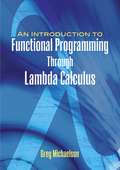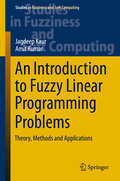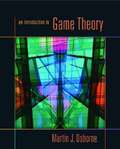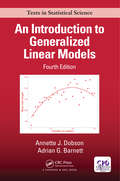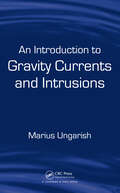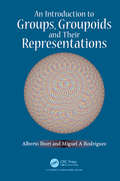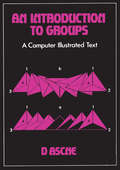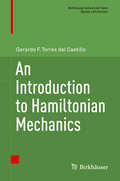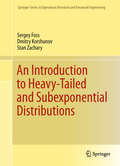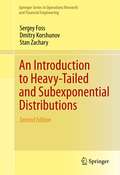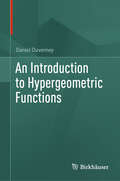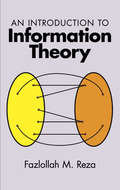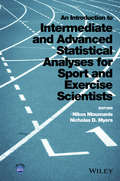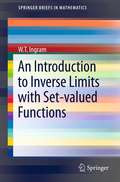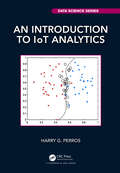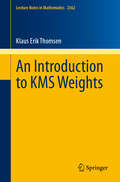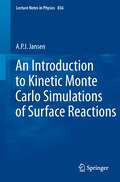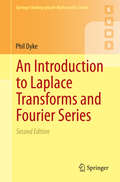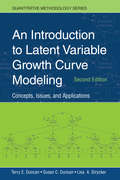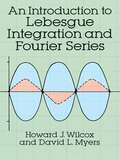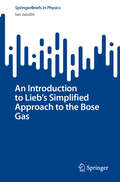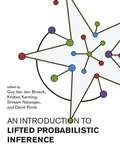- Table View
- List View
An Introduction to Functional Programming Through Lambda Calculus
by Greg MichaelsonFunctional programming is rooted in lambda calculus, which constitutes the world's smallest programming language. This well-respected text offers an accessible introduction to functional programming concepts and techniques for students of mathematics and computer science. The treatment is as nontechnical as possible, and it assumes no prior knowledge of mathematics or functional programming. Cogent examples illuminate the central ideas, and numerous exercises appear throughout the text, offering reinforcement of key concepts. All problems feature complete solutions. <P><P><i>Advisory: Bookshare has learned that this book offers only partial accessibility. We have kept it in the collection because it is useful for some of our members. To explore further access options with us, please contact us through the Book Quality link on the right sidebar. Benetech is actively working on projects to improve accessibility issues such as these.</i>
An Introduction to Fuzzy Linear Programming Problems: Theory, Methods and Applications (Studies in Fuzziness and Soft Computing #340)
by Amit Kumar Jagdeep KaurThe book presents a snapshot of the state of the art in the field of fully fuzzy linear programming. The main focus is on showing current methods for finding the fuzzy optimal solution of fully fuzzy linear programming problems in which all the parameters and decision variables are represented by non-negative fuzzy numbers. It presents new methods developed by the authors, as well as existing methods developed by others, and their application to real-world problems, including fuzzy transportation problems. Moreover, it compares the outcomes of the different methods and discusses their advantages/disadvantages. As the first work to collect at one place the most important methods for solving fuzzy linear programming problems, the book represents a useful reference guide for students and researchers, providing them with the necessary theoretical and practical knowledge to deal with linear programming problems under uncertainty.
An Introduction to Game Theory
by Martin J. OsborneAn Introduction to Game Theory, by Martin J. Osborne, presents the main principles of game theory and shows how they can be used to understand economic, social, political, and biological phenomena. The book introduces in an accessible manner the main ideas behind the theory rather than their mathematical expression. All concepts are defined precisely, and logical reasoning is used throughout. The book requires an understanding of basic mathematics but assumes no specific knowledge of economics, political science, or other social or behavioral sciences. <p><p>Coverage includes the fundamental concepts of strategic games, extensive games with perfect information, and coalitional games; the more advanced subjects of Bayesian games and extensive games with imperfect information; and the topics of repeated games, bargaining theory, evolutionary equilibrium, rationalizability, and maxminimization. The book offers a wide variety of illustrations from the social and behavioral sciences and more than 280 exercises. Each topic features examples that highlight theoretical points and illustrations that demonstrate how the theory may be used. Explaining the key concepts of game theory as simply as possible while maintaining complete precision, An Introduction to Game Theory is ideal for undergraduate and introductory graduate courses in game theory.
An Introduction to Generalized Linear Models (Chapman & Hall/CRC Texts in Statistical Science)
by Adrian G. Barnett Annette J. Dobson<p>An Introduction to Generalized Linear Models, Fourth Edition provides a cohesive framework for statistical modelling, with an emphasis on numerical and graphical methods. This new edition of a bestseller has been updated with new sections on non-linear associations, strategies for model selection, and a Postface on good statistical practice. <p>Like its predecessor, this edition presents the theoretical background of generalized linear models (GLMs) before focusing on methods for analyzing particular kinds of data. It covers Normal, Poisson, and Binomial distributions; linear regression models; classical estimation and model fitting methods; and frequentist methods of statistical inference. After forming this foundation, the authors explore multiple linear regression, analysis of variance (ANOVA), logistic regression, log-linear models, survival analysis, multilevel modeling, Bayesian models, and Markov chain Monte Carlo (MCMC) methods.</p>
An Introduction to Gravity Currents and Intrusions
by Marius UngarishGravity currents and intrusions are the ubiquitous phenomena where a fluid of one density flows horizontally into a fluid of a different density. For researchers and engineers, the ability to understand and predict these flow fields is essential in wide-ranging applications including those involved with atmospheric and ocean dynamics, the propagati
An Introduction to Groups, Groupoids and Their Representations: An Introduction
by Alberto Ibort Miguel A. RodriguezThis book offers an introduction to the theory of groupoids and their representations encompassing the standard theory of groups. Using a categorical language, developed from simple examples, the theory of finite groupoids is shown to knit neatly with that of groups and their structure as well as that of their representations is described. The book comprises numerous examples and applications, including well-known games and puzzles, databases and physics applications. Key concepts have been presented using only basic notions so that it can be used both by students and researchers interested in the subject. Category theory is the natural language that is being used to develop the theory of groupoids. However, categorical presentations of mathematical subjects tend to become highly abstract very fast and out of reach of many potential users. To avoid this, foundations of the theory, starting with simple examples, have been developed and used to study the structure of finite groups and groupoids. The appropriate language and notions from category theory have been developed for students of mathematics and theoretical physics. The book presents the theory on the same level as the ordinary and elementary theories of finite groups and their representations, and provides a unified picture of the same. The structure of the algebra of finite groupoids is analysed, along with the classical theory of characters of their representations. Unnecessary complications in the formal presentation of the subject are avoided. The book offers an introduction to the language of category theory in the concrete setting of finite sets. It also shows how this perspective provides a common ground for various problems and applications, ranging from combinatorics, the topology of graphs, structure of databases and quantum physics.
An Introduction to Groups: A Computer Illustrated Text (A\computer Illustrated Text Ser.)
by D AscheAn Introduction to Groups: A Computer Illustrated Text discusses all the concepts necessary for a thorough understanding of group theory. The book covers various theorems, including Lagrange and Sylow. It also details Cayley tables, Burnside's lemma, homomorphisms, and dicyclic groups. The book is ideal for advanced mathematics students and beginning undergraduates.
An Introduction to Hamiltonian Mechanics (Birkhäuser Advanced Texts Basler Lehrbücher)
by Gerardo F. Torres del CastilloThis textbook examines the Hamiltonian formulation in classical mechanics with the basic mathematical tools of multivariate calculus. It explores topics like variational symmetries, canonoid transformations, and geometrical optics that are usually omitted from an introductory classical mechanics course. For students with only a basic knowledge of mathematics and physics, this book makes those results accessible through worked-out examples and well-chosen exercises.For readers not familiar with Lagrange equations, the first chapters are devoted to the Lagrangian formalism and its applications. Later sections discuss canonical transformations, the Hamilton–Jacobi equation, and the Liouville Theorem on solutions of the Hamilton–Jacobi equation. Graduate and advanced undergraduate students in physics or mathematics who are interested in mechanics and applied math will benefit from this treatment of analytical mechanics. The text assumes the basics of classical mechanics, as well as linear algebra, differential calculus, elementary differential equations and analytic geometry. Designed for self-study, this book includes detailed examples and exercises with complete solutions, although it can also serve as a class text.
An Introduction to Heavy-Tailed and Subexponential Distributions (Springer Series in Operations Research and Financial Engineering #38)
by Dmitry Korshunov Stan Zachary Sergey FossHeavy-tailed probability distributions are an important component in the modeling of many stochastic systems. They are frequently used to accurately model inputs and outputs of computer and data networks and service facilities such as call centers. They are an essential for describing risk processes in finance and also for insurance premia pricing, and such distributions occur naturally in models of epidemiological spread. The class includes distributions with power law tails such as the Pareto, as well as the lognormal and certain Weibull distributions.<P><P> This monograph defines the classes of long-tailed and subexponential distributions in one dimension and provides a complete and comprehensive description of their properties. New results are presented in a simple, coherent and systematic way. This leads to a comprehensive exposition of tail properties of sums of independent random variables whose distributions belong to the long-tailed and subexponential class.<P> The book includes a discussion of and references to contemporary areas of applications and also contains preliminary mathematical material which makes the book self contained. Modelers in the fields of finance, insurance, network science and environmental studies will find this book to be an essential reference.
An Introduction to Heavy-Tailed and Subexponential Distributions, 2nd Edition (Springer Series in Operations Research and Financial Engineering)
by Dmitry Korshunov Stan Zachary Sergey FossHeavy-tailed probability distributions are an important component in the modeling of many stochastic systems. They are frequently used to accurately model inputs and outputs of computer and data networks and service facilities such as call centers. They are an essential for describing risk processes in finance and also for insurance premia pricing, and such distributions occur naturally in models of epidemiological spread. The class includes distributions with power law tails such as the Pareto, as well as the lognormal and certain Weibull distributions.<P><P> One of the highlights of this new edition is that it includes problems at the end of each chapter. Chapter 5 is also updated to include interesting applications to queueing theory, risk, and branching processes. New results are presented in a simple, coherent and systematic way.<P> Graduate students as well as modelers in the fields of finance, insurance, network science and environmental studies will find this book to be an essential reference.
An Introduction to Homological Algebra
by Charles A. WeibelThe landscape of homological algebra has evolved over the past half-century into a fundamental tool for the working mathematician. This book provides a unified account of homological algebra as it exists today. The historical connection with topology, regular local rings, and semi-simple Lie algebras is also described. The first half of the book takes as its subject the canonical topics in homological algebra: derived functors, Tor and Ext, projective dimensions and spectral sequences. Homology of group and Lie algebras illustrate these topics. Intermingled are less canonical topics, such as the derived inverse limit functor lim1, local cohomology, Galois cohomology, and affine Lie algebras. The last part of the book covers less traditional topics that are a vital part of the modern homological toolkit: simplicial methods, Hochschild and cyclic homology, derived categories and total derived functors.
An Introduction to Hopf Algebras
by Robert G. UnderwoodWith wide-ranging connections to fields from theoretical physics to computer science, Hopf algebras offer students a glimpse at the applications of abstract mathematics. This book is unique in making this engaging subject accessible to advanced undergraduate and beginning graduate students. After providing a self-contained introduction to group and ring theory, the book thoroughly treats the concept of the spectrum of a ring and the Zariski topology. In this way the student transitions smoothly from basic abstract algebra to Hopf algebras. The importance of Hopf orders is underscored with applications to algebraic number theory, Galois module theory and the theory of formal groups. By the end of the book, readers will be familiar with established results in the field and ready to pose research questions of their own.
An Introduction to Hypergeometric Functions
by Daniel DuverneyThis textbook provides an elementary introduction to hypergeometric functions, which generalize the usual elementary functions. It includes plenty of solved exercises and it is appropriate for a wide audience, starting from undergraduate students in mathematics, physics and engineering. Since the presented functions are limited to hypergeometric functions of a real variable, the only prerequisites are the basics of real analysis.
An Introduction to Information Theory (Dover Books on Mathematics)
by Fazlollah M. RezaWritten for an engineering audience, this book has a threefold purpose: (1) to present elements of modern probability theory — discrete, continuous, and stochastic; (2) to present elements of information theory with emphasis on its basic roots in probability theory; and (3) to present elements of coding theory.The emphasis throughout the book is on such basic concepts as sets, the probability measure associated with sets, sample space, random variables, information measure, and capacity. These concepts proceed from set theory to probability theory and then to information and coding theories. No formal prerequisites are required other than the usual undergraduate mathematics included in an engineering or science program. However, since these programs may not include a course in probability, the author presents an introductory treatment of probability for those who wish to pursue the general study of statistical theory of communications. The book is divided into four parts: memoryless discrete themes, memoryless continuum, schemes with memory, and an outline of some recent developments. An appendix contains notes to help familiarize the reader with the literature in the field, while the inclusion of many reference tables and an extensive bibliography with some 200 entries makes this an excellent resource for any student in the field.
An Introduction to Intermediate and Advanced Statistical Analyses for Sport and Exercise Scientists
by Nicholas D. Myers Nikos NtoumanisNtoumanis and Myers have done sport and exercise science researchers and students a tremendous service in producing An Introduction to Intermediate and Advanced Statistical Analyses for Sport and Exercise Scientists. This book has an outstanding compilation of comprehensible chapters dealing with the important concepts and technical minutia of the statistical analyses that sport and exercise science scholars use (or should be using!) in their efforts to conduct meaningful research in the field. It is a resource that all sport and exercise scientists and their students should have on their book shelves. Robert Eklund, School of Sport, University of Stirling, UK Motivating, to have a statistics text devoted to enabling researchers studying sport and exercise science to apply the most sophisticated analytical techniques to their data. Authors hit the mark between using technical language as necessary and user-friendly terms or translations to keep users encouraged. Text covers traditional and well-used tools but also less common and more complex tools, but always with familiar examples to make their explanations come alive. As a dynamic systems theorist and developmentalist, I would love to see more researchers in my area create study designs that would enable the use of tools outlined here, such as multilevel structural equation modeling (MSEM) or mediation & moderation analyses, to uncover cascades of relations among subsystems contributing to motor performance, over time. This text can facilitate that outcome. Beverly D. Ulrich, School of Kinesiology, University of Michigan, USA The domain of quantitative methods is constantly evolving and expanding. This means that there is tremendous pressure on researchers to stay current, both in terms of best practices and improvements in more traditional methods as well as increasingly complex new methods. With this volume Ntoumanis and Myers present a nice cross-section of both, helping sport and exercise science researchers to address old questions in better ways, and, even more excitingly, to address new questions entirely. I have no doubt that this volume will quickly become a lovingly dog-eared companion for students and researchers, helping them to continue to move the field forward. Gregory R. Hancock, University of Maryland and Center for Integrated Latent Variable Research (CILVR), USA
An Introduction to Inverse Limits with Set-valued Functions (SpringerBriefs in Mathematics)
by W. T. IngramInverse limits with set-valued functions are quickly becoming a popular topic of research due to their potential applications in dynamical systems and economics. This brief provides a concise introduction dedicated specifically to such inverse limits. The theory is presented along with detailed examples which form the distinguishing feature of this work. The major differences between the theory of inverse limits with mappings and the theory with set-valued functions are featured prominently in this book in a positive light. The reader is assumed to have taken a senior level course in analysis and a basic course in topology. Advanced undergraduate and graduate students, and researchers working in this area will find this brief useful.
An Introduction to IoT Analytics (Chapman & Hall/CRC Data Science Series)
by Harry G. PerrosThis book covers techniques that can be used to analyze data from IoT sensors and addresses questions regarding the performance of an IoT system. It strikes a balance between practice and theory so one can learn how to apply these tools in practice with a good understanding of their inner workings. This is an introductory book for readers who have no familiarity with these techniques. The techniques presented in An Introduction to IoT Analytics come from the areas of machine learning, statistics, and operations research. Machine learning techniques are described that can be used to analyze IoT data generated from sensors for clustering, classification, and regression. The statistical techniques described can be used to carry out regression and forecasting of IoT sensor data and dimensionality reduction of data sets. Operations research is concerned with the performance of an IoT system by constructing a model of the system under study and then carrying out a what-if analysis. The book also describes simulation techniques. Key Features IoT analytics is not just machine learning but also involves other tools, such as forecasting and simulation techniques. Many diagrams and examples are given throughout the book to fully explain the material presented. Each chapter concludes with a project designed to help readers better understand the techniques described. The material in this book has been class tested over several semesters. Practice exercises are included with solutions provided online at www.routledge.com/9780367686314 Harry G. Perros is a Professor of Computer Science at North Carolina State University, an Alumni Distinguished Graduate Professor, and an IEEE Fellow. He has published extensively in the area of performance modeling of computer and communication systems.
An Introduction to KMS Weights (Lecture Notes in Mathematics #2362)
by Klaus Erik ThomsenThis book provides an introduction to the theory of KMS weights and KMS states, which play an important role in mathematical physics and other applications of operator algebras. Leading from the definitions to some of the most recent research results, it covers advanced topics such as the Laca-Neshveyev theorem, elements of the modular theory of von Neumann algebras, the geometry of the set of KMS weights, duality (for KMS weights on crossed products), the relationship between KMS weights and traces and the types of factors associated with extremal KMS weights. Some of the material is new, in the sense that the proofs and results are published here for the first time. This relatively self-contained book will be useful both to researchers in the area of operator algebras and to more advanced students who wish to enter this field.
An Introduction to Kinetic Monte Carlo Simulations of Surface Reactions (Lecture Notes in Physics #856)
by A.P.J. JansenKinetic Monte Carlo (kMC) simulations still represent a quite new area of research, with a rapidly growing number of publications. Broadly speaking, kMC can be applied to any system describable as a set of minima of a potential-energy surface, the evolution of which will then be regarded as hops from one minimum to a neighboring one. The hops in kMC are modeled as stochastic processes and the algorithms use random numbers to determine at which times the hops occur and to which neighboring minimum they go. Sometimes this approach is also called dynamic MC or Stochastic Simulation Algorithm, in particular when it is applied to solving macroscopic rate equations. This book has two objectives. First, it is a primer on the kMC method (predominantly using the lattice-gas model) and thus much of the book will also be useful for applications other than to surface reactions. Second, it is intended to teach the reader what can be learned from kMC simulations of surface reaction kinetics. With these goals in mind, the present text is conceived as a self-contained introduction for students and non-specialist researchers alike who are interested in entering the field and learning about the topic from scratch.
An Introduction to Kolmogorov Complexity and Its Applications (Texts in Computer Science)
by Ming Li Paul M. B. Vitányi"The book is outstanding and admirable in many respects. ... is necessary reading for all kinds of readers from undergraduate students to top authorities in the field." Journal of Symbolic Logic Written by two experts in the field, this is the only comprehensive and unified treatment of the central ideas and applications of Kolmogorov complexity. The book presents a thorough treatment of the subject with a wide range of illustrative applications. Such applications include the randomness of finite objects or infinite sequences, Martin-Loef tests for randomness, information theory, computational learning theory, the complexity of algorithms, and the thermodynamics of computing. It will be ideal for advanced undergraduate students, graduate students, and researchers in computer science, mathematics, cognitive sciences, philosophy, artificial intelligence, statistics, and physics. The book is self-contained in that it contains the basic requirements from mathematics and computer science. Included are also numerous problem sets, comments, source references, and hints to solutions of problems. New topics in this edition include Omega numbers, Kolmogorov-Loveland randomness, universal learning, communication complexity, Kolmogorov's random graphs, time-limited universal distribution, Shannon information and others.
An Introduction to Laplace Transforms and Fourier Series (Springer Undergraduate Mathematics Series)
by Phil DykeLaplace transforms continue to be a very important tool for the engineer, physicist and applied mathematician. They are also now useful to financial, economic and biological modellers as these disciplines become more quantitative. Any problem that has underlying linearity and with solution based on initial values can be expressed as an appropriate differential equation and hence be solved using Laplace transforms. In this book, there is a strong emphasis on application with the necessary mathematical grounding. There are plenty of worked examples with all solutions provided. This enlarged new edition includes generalised Fourier series and a completely new chapter on wavelets. Only knowledge of elementary trigonometry and calculus are required as prerequisites. An Introduction to Laplace Transforms and Fourier Series will be useful for second and third year undergraduate students in engineering, physics or mathematics, as well as for graduates in any discipline such as financial mathematics, econometrics and biological modelling requiring techniques for solving initial value problems.
An Introduction to Latent Variable Growth Curve Modeling: Concepts, Issues, and Application, Second Edition (Quantitative Methodology Series)
by Terry E. Duncan Susan C. Duncan Lisa A. StryckerThis book provides a comprehensive introduction to latent variable growth curve modeling (LGM) for analyzing repeated measures. It presents the statistical basis for LGM and its various methodological extensions, including a number of practical examples of its use. It is designed to take advantage of the reader’s familiarity with analysis of variance and structural equation modeling (SEM) in introducing LGM techniques. Sample data, syntax, input and output, are provided for EQS, Amos, LISREL, and Mplus on the book’s CD. Throughout the book, the authors present a variety of LGM techniques that are useful for many different research designs, and numerous figures provide helpful diagrams of the examples. Updated throughout, the second edition features three new chapters—growth modeling with ordered categorical variables, growth mixture modeling, and pooled interrupted time series LGM approaches. Following a new organization, the book now covers the development of the LGM, followed by chapters on multiple-group issues (analyzing growth in multiple populations, accelerated designs, and multi-level longitudinal approaches), and then special topics such as missing data models, LGM power and Monte Carlo estimation, and latent growth interaction models. The model specifications previously included in the appendices are now available on the CD so the reader can more easily adapt the models to their own research. This practical guide is ideal for a wide range of social and behavioral researchers interested in the measurement of change over time, including social, developmental, organizational, educational, consumer, personality and clinical psychologists, sociologists, and quantitative methodologists, as well as for a text on latent variable growth curve modeling or as a supplement for a course on multivariate statistics. A prerequisite of graduate level statistics is recommended.
An Introduction to Lebesgue Integration and Fourier Series (Dover Books on Mathematics)
by David L. Myers Howard J. WilcoxThis book arose out of the authors' desire to present Lebesgue integration and Fourier series on an undergraduate level, since most undergraduate texts do not cover this material or do so in a cursory way. The result is a clear, concise, well-organized introduction to such topics as the Riemann integral, measurable sets, properties of measurable sets, measurable functions, the Lebesgue integral, convergence and the Lebesgue integral, pointwise convergence of Fourier series and other subjects.The authors not only cover these topics in a useful and thorough way, they have taken pains to motivate the student by keeping the goals of the theory always in sight, justifying each step of the development in terms of those goals. In addition, whenever possible, new concepts are related to concepts already in the student's repertoire.Finally, to enable readers to test their grasp of the material, the text is supplemented by numerous examples and exercises. Mathematics students as well as students of engineering and science will find here a superb treatment, carefully thought out and well presented , that is ideal for a one semester course. The only prerequisite is a basic knowledge of advanced calculus, including the notions of compactness, continuity, uniform convergence and Riemann integration.
An Introduction to Lieb's Simplified Approach to the Bose Gas (SpringerBriefs in Physics)
by Ian JauslinThis book explores Lieb's Simplified approach to the ground state of systems of interacting bosons. While extensive research has delved into the behavior of interacting bosons, persistent challenges, such as proving Bose-Einstein condensation, remain. Introduced by Lieb in 1963, the Simplified approach has been the object of renewed attention in recent years, revealing surprising and promising results. Notably, this approach provides ground state energy predictions that agree with many-body systems asymptotically at both low and high densities. It further predicts a condensate fraction and correlation function that agree with Bogolyubov theory at low densities, and numerical predictions match quantum Monte Carlo simulations across all densities. This suggests that Lieb's Simplified approach could serve as a potent tool for reimagining the study of interacting bosons. The book defines Lieb's Simplified approach, discusses its predictions, and presents known analytical and numerical results. It is designed for advanced students and young researchers working in the fields of mathematical physics, quantum many-body physics and Bose-Einstein condensates.
An Introduction to Lifted Probabilistic Inference (Neural Information Processing series)
by David PooleRecent advances in the area of lifted inference, which exploits the structure inherent in relational probabilistic models.Statistical relational AI (StaRAI) studies the integration of reasoning under uncertainty with reasoning about individuals and relations. The representations used are often called relational probabilistic models. Lifted inference is about how to exploit the structure inherent in relational probabilistic models, either in the way they are expressed or by extracting structure from observations. This book covers recent significant advances in the area of lifted inference, providing a unifying introduction to this very active field. After providing necessary background on probabilistic graphical models, relational probabilistic models, and learning inside these models, the book turns to lifted inference, first covering exact inference and then approximate inference. In addition, the book considers the theory of liftability and acting in relational domains, which allows the connection of learning and reasoning in relational domains.
